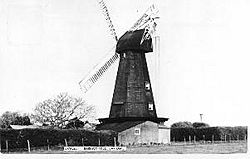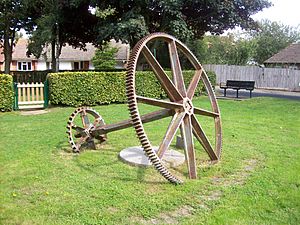Black Mill, Barham facts for kids
Quick facts for kids Black Mill, Barham |
|
|---|---|

The mill when a working mill
|
|
| Origin | |
| Mill name | Black Mill Barham Downs Mill |
| Grid reference | TR 214 510 |
| Coordinates | 51°12′54″N 1°10′08″E / 51.215°N 1.169°E |
| Year built | 1834 |
| Information | |
| Purpose | Corn mill |
| Type | Smock mill |
| Storeys | Three-storey smock |
| Base storeys | Two-storey base |
| Smock sides | Eight-sided |
| No. of sails | Four |
| Type of sails | Patent sails |
| Windshaft | cast iron |
| Winding | Fantail |
| Fantail blades | Six blades |
| No. of pairs of millstones | Four pairs |
| Year lost | 1970 |
| Other information | Burnt down while under restoration. |
The Black Mill, also known as Barham Downs Mill, was a special type of windmill called a smock mill. It was located in Barham, Kent, England. Sadly, this historic mill was accidentally destroyed by fire in 1970 while it was being repaired.
Contents
The Mill's Long History
The Black Mill was actually the third windmill to stand on this spot. People have used windmills on Barham Down for a very long time. Records show a mill here as far back as the 1200s!
Maps from the 1500s and 1600s also show a mill on Barham Down. This earlier mill was first built a bit lower down the hill. Later, it was moved to a higher spot.
Another mill was shown on an Ordnance Survey map from the early 1800s.
Building the Black Mill
The Black Mill we are talking about was built in 1834. It was constructed by John Holman, a famous millwright from Canterbury. A millwright is a skilled builder who specializes in designing, building, and repairing mills.
The mill was used for many years to grind corn. Several people worked there, including H S Pledge and R Walter, who ran it for over 50 years. Later, T Denne and Sons took over.
Challenges and Repairs
The mill faced some tough times. On June 17, 1878, lightning struck the mill! It lost one of its sails. More than £150 had to be spent to fix the damage. This was a lot of money back then!
The last owner, Mr. E Mannering, cared a lot about the mill. In 1946, he added a fantail from another windmill in Willesborough. A fantail is a small windmill at the back of the main mill. It helps turn the main mill so its sails always face the wind.
Mr. Mannering also restored the mill in 1956. He even received a special award called a Windmill Certificate for his hard work. The company Holman's of Canterbury did the repair work. This was the last time they worked on a windmill before they stopped doing that kind of job. Kent County Council also helped, giving £400 for the restoration. This work included replacing two sails that a big storm had blown off in 1951.
The mill even appeared in a movie! It was featured in the 1955 film "Raising a Riot," which starred Kenneth More.
The Mill's Sad End
In the late 1960s, Kent County Council bought the mill. They planned to restore it even more. But on March 3, 1970, a terrible accident happened. A spark from a bonfire nearby set the mill on fire, and it burned down completely.
A new stage, which was being prepared for the restored Black Mill, was saved. This stage was later given to Draper's Windmill in Margate and was put up there.
How the Black Mill Worked
The Black Mill was a four-storey smock mill. It stood on a strong base made of brick, which was one storey high.
It had four large sails called patent sails. These sails were attached to a strong cast-iron shaft. The mill used a fantail to turn itself into the wind.
Inside, the mill had four pairs of millstones. These heavy stones would grind corn into flour.
Millers of Black Mill
Many people worked as millers at the Black Mill over the years:
- E Lawrence was a miller in 1845.
- Henry Sturgess Pledge was a miller in 1850. He later worked at other mills.
- Richard Walter also worked here.
- T Denne and Sons Ltd were millers in 1933. Their business is still around today!
- W Mannering was another miller.


